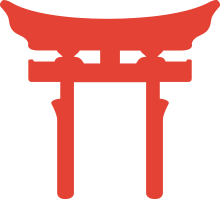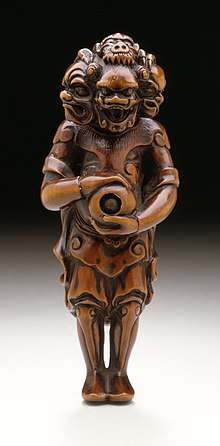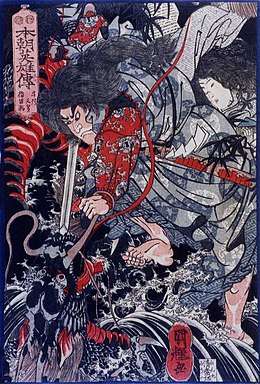Japanese mythology
Japanese mythology is a collection of traditional stories, folktales, and beliefs that emerged in the islands of the Japanese archipelago. Shinto and Buddhist traditions are the cornerstones of Japanese mythology.[1] The history of thousands of years of contact with China, Korea, Ainu, and Okinawan myths are also key influences in Japanese mythology.[1][2][3]
| Part of the series on |
| Japanese mythology and folklore |
|---|
 |
| Mythic texts |
| Divinities |
| Legendary creatures and urban legends |
| Mythical and sacred locations |
| Sacred objects |
| Shintō and Buddhism |
| Part of a series on the |
| Culture of Japan |
|---|
 |
| History |
| People |
| Languages |
| Cuisine |
| Festivals |
|
Music and performing arts |
|
Organisations |
|
| Part of a series on |
| Shinto |
|---|
 |
| Practices and beliefs |
| Shinto shrines |
| Notable Kami |
| Important literature |
|
| See also |
Japanese myths are tied to the topography of the archipelago as well as agriculturally-based folk religion, and the Shinto pantheon holds countless kami (Japanese for "god(s)" or "spirits").[1] This article will discuss cosmogony, important deities, modern interpretations, cultural significance, and the influence of these myths.
Two important sources for Japanese myths as they are recognized today are the Kojiki and the Nihon Shoki.[4][5] The Kojiki, or "Record of Ancient Matters," is the oldest surviving account of Japan's myths, legends, and history.[6] Additionally, the Shintōshū describes the origins of Japanese deities from a Buddhist perspective.[7]
One notable feature of Japanese mythology is its explanation of the origin of the Imperial Family, which has been used historically to assign godhood to the imperial line.[4]
Note that Japanese is not transliterated consistently across all sources (see spelling of proper nouns).
The Japanese Pantheon
Japanese gods and goddesses, called kami, are uniquely numerous (there are at least eight million) and varied in power and stature.[1] They are usually descendants from the original trio of gods that were born from nothing in the primordial oil that was the world before the kami began to shape it.[1][9] There are easily as many kami in Japanese myth as there are distinct natural features, and most kami are associated with natural phenomena.[1] Kami can take many shapes and forms, some look almost human in depictions found by archaeologists; meanwhile, other kami look like hybrids of humans and creatures, or may not look human at all. One example of a kami who looks almost human in depictions is the ruler of the Seas Ryujin.[1] On the other hand, kami like Ningi and Amaterasu are often depicted as human in their forms.[1]
Shinto originated in Japan, and the Kojiki and Nihon Shoki tell the tales of the Shinto pantheon's origins.[1] It is important to note that Shintoism is still practiced today in Japan. In Shinto belief, kami has multiple meanings and could also be translated as "spirit" and all aspects of nature have a kami according to this system.[1] Myths often tell stories of particular, local deities and kami; for example, the kami of a mountain or a nearby lake.[1] Most kami take their origins from Shinto beliefs, but the influence of Buddhism also affected the pantheon.[1] Contact with other cultures usually had some influence on Japanese myth. In the fourteenth century, Christianity found its way to Japan through St. Francis Xavier and there was also contact with westerners.[1] However, during the Tokugawa shogunate Christians were executed in Japan.[1] Twenty Christians were crucified before that while Toyotomi Hideyoshi was consolidating his power after the assassination of Oda Nobunaga.[1] Christianity was banned in Japan until well into the nineteenth century.[1]
Folklore Heroes
As in other cultures, Japanese mythology accounts for not only the actions of supernatural beings but also the adventures and lives of folk heroes. There are many Japanese heroes that are associated with specific locations in Japan, and others that are more well-known across the archipelago.[1] Some heroes are thought to have been real people, such as the Forty-seven rōnin, but their legacy has been transformed into great folktales that depict the historical figures as more gifted, powerful, or knowledgeable than the average person.[1] The heroic adventures of these heroes range from acts of kindness and devotion, such as the myth of Shita-kiri Suzume, to battling frightful enemies, as in the tale of Momotaro. [9][20]
Themes that appear in the folklore concerning heroes are moral lessons, or stories that function as parables. The tale of Shita-kiri Suzume, for example, warns of the dangers of greed, avarice, and jealousy through the example of an old couple's experiences with a fairy who disguised herself as a sparrow to test the old man.[9] The influence of Bushido is noticeable in the behavior of heroes, and heroes often were also warriors.[1] Momotaro, born from a peach for a childless couple to raise, is a mythic hero who embodied courage and dutifulness as he went on a journey to defeat oni who were kidnapping, raping, and pillaging his home island.[1] The tale of Momotaro also shares in the themes of violence, sexual violence, and deities or demons devouring humans.[21] Stories of sexual violence are common in the Buddhist text Nihon ryōiki, while stories of people being devoured by mountain deities are found as if they are historical accounts in the fudoki.[21] In Japanese folklore, heroes like Momotaro rescue women from violent kami and oni. Although the exploits of heroes are well known, Japanese mythology also featured heroines.[1] Ototachibana, the wife of Yamato Takeru, threw herself into the sea to save her husband's ship and quell the wrath of the storm that threatened them.[1] Yamato Takeru, once safe, built a tomb for her and his mourning utterance for his wife caused Eastern Honshu to be called Adzuma.[1]
Mythological Creatures

See also
- Ainu mythology
- Japanese Buddhism
- Japanese folklore
- Japanese mythology in popular culture
- Japanese urban legends
- Kami
- Kamui
- Kuni-yuzuri
- List of Japanese deities
- Philippine mythology
- Seven Lucky Gods
- Hōsōshin demon
- Shinto
- Yokai
- Yurei
Spelling of proper nouns
Many deities appear in Japanese mythology, and many of them have multiple aliases. Furthermore, some of their names are comparatively long. This article, therefore, lists only the most prominent names and gives them in one of their abbreviated forms, other abbreviated forms are also in use.
(For instance, Ninigi, or Ame-Nigishikuni-Nigishiamatsuhiko-Hikono-no-Ninigi-no-Mikoto in full, may also be abbreviated as Hikoho-no-Ninigi or Hono-Ninigi.)
In some parts of this article, proper names are written in a historical manner. In this article, underlined h, y, and w denote silent letters; they are omitted from modern spelling. Other syllables are modernized as follows (see also Japanese romanization systems). Note that some blend of these conventions is also often used.
- hu is modernized as fu.
- zi and di are modernized as ji (the distinction disappeared).
- oo is modernized as o or oh.
- For instance, various spellings of Ohonamuji include Oonamuji, Ohnamuji, and others.
References
- Piggott, Juliet. Japanese mythology (New revised ed.). New York, N.Y. pp. 6–8. ISBN 0-911745-09-2. OCLC 9971207.
- Tylor, Edward B. (1877). "Remarks on Japanese Mythology". The Journal of the Anthropological Institute of Great Britain and Ireland. 6: 55–58. doi:10.2307/2841246. JSTOR 2841246.
- Kitagawa, Joseph M. (1963). "Prehistoric Background of Japanese Religion". History of Religions. 2 (2): 292–328. doi:10.1086/462466. ISSN 0018-2710. JSTOR 1062069.
- ANDASSOVA, Maral (2019). "Emperor Jinmu in the Kojiki". Japan Review (32): 5–16. ISSN 0915-0986. JSTOR 26652947.
- Jun'ichi, Isomae; 一, 磯 前 順; Thal, Sarah E. (2000). "Reappropriating the Japanese Myths: Motoori Norinaga and the Creation Myths of the Kojiki and Nihon shoki". Japanese Journal of Religious Studies. 27 (1/2): 15–39. ISSN 0304-1042. JSTOR 30233639.
- Smits, Gregory J. (1991). "Political Thought in Japanese Historical Writing: From Kojiki (712) to Tokushi Yoron (1712). By John S. Brownlee. Toronto: Wilfrid Laurier University Press, 1991. xvii, 158 pp. $35.00". The Journal of Asian Studies. 51 (3): 666–667. doi:10.2307/2057985. ISSN 0021-9118. JSTOR 2057985.
- Kadoya, Atsushi; 門屋溫; Padoan, Tatsuma (2006). "On the Formation of Shintō Icons". Cahiers d'Extrême-Asie. 16: 151–182. doi:10.3406/asie.2006.1255. ISSN 0766-1177. JSTOR 44171454.
- Duthie, Torquil (2014-01-01). "Preliminary Material". Man'yōshū and the Imperial Imagination in Early Japan. Man’yōshū and the Imperial Imagination in Early Japan. BRILL. doi:10.1163/9789004264540_001. ISBN 978-90-04-26454-0. Italic or bold markup not allowed in:
|work=(help) - Lewis, Scott (2018). Mythology: Mega Collection. Scott Lewis.
- Great Mythologies of the World. The Great Courses. 2015. pp. 250–350.
- Pauley, Daniel C. (2009). Pauley's guide : a dictionary of Japanese martial arts and culture. Anaguma Seizan Publications. OCLC 384268610.
- Louis-Frédéric, 1923- (2002). Japan encyclopedia. Roth, Käthe. Cambridge, Mass.: Belknap Press of Harvard University Press. ISBN 0-674-00770-0. OCLC 48943301.
- Kōnoshi, Takamitsu (1984). "The Land of Yomi: On the Mythical World of the Kojiki". Japanese Journal of Religious Studies. 11 (1): 57–76. doi:10.18874/jjrs.11.1.1984.57-76. ISSN 0304-1042. JSTOR 30233312.
- Murakami, Fuminobu (1988). "Incest and Rebirth in Kojiki". Monumenta Nipponica. 43 (4): 455–463. doi:10.2307/2384797. ISSN 0027-0741. JSTOR 2384797.
- Aston, W. G. (1899). "Japanese Myth". Folklore. 10 (3): 294–324. doi:10.1080/0015587X.1899.9720502. ISSN 0015-587X. JSTOR 1253583.
- Hoffman, Michael (2009-07-12). "Land of the Sun Goddess". The Japan Times Online. ISSN 0447-5763. Retrieved 2020-02-07.
- Metevelis, Peter (1983). A Reference Guide to the Nihonshoki Myths, Asian Folklore Studies. Vol 52, No 2, p. 383–8.
- Seagrave, Sterling. (2001). The Yamato dynasty : the secret history of Japan's imperial family. Seagrave, Peggy. (1st Broadway books trade pbk. ed.). New York: Broadway Books. ISBN 0-7679-0497-4. OCLC 47813347.
- "THE CONSTITUTION OF JAPAN". japan.kantei.go.jp. Retrieved 2020-02-07.
- Antoni, Klaus (1991). "Momotarō (The Peach Boy) and the Spirit of Japan: Concerning the Function of a Fairy Tale in Japanese Nationalism of the Early Shōwa Age". Asian Folklore Studies. 50 (1): 155–188. doi:10.2307/1178189. ISSN 0385-2342. JSTOR 1178189.
- Kelsey, W. Michael (1981). "The Raging Deity in Japanese Mythology". Asian Folklore Studies. 40 (2): 213–236. doi:10.2307/1177865. ISSN 0385-2342. JSTOR 1177865.
External links
- Romance stories from old Japan, pre-1919—Free to read and full-text search.
- A Multilingual Electronic Text Collection of Folk Tales for Casual Users Using Off-the-Shelf Browsers



